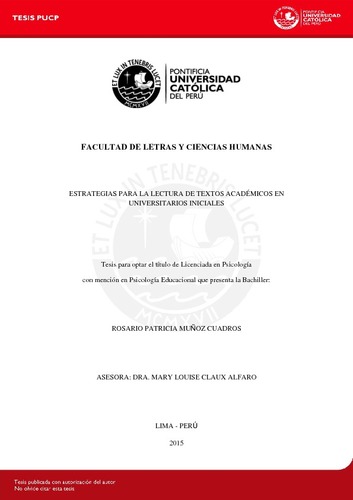| dc.contributor.advisor | Claux Alfaro, Mary Louise | es_ES |
| dc.contributor.author | Muñoz Cuadros, Rosario Patricia | es_ES |
| dc.date.accessioned | 2015-06-03T23:43:05Z | es_ES |
| dc.date.available | 2015-06-03T23:43:05Z | es_ES |
| dc.date.created | 2015 | es_ES |
| dc.date.issued | 2015-06-03 | es_ES |
| dc.identifier.uri | http://hdl.handle.net/20.500.12404/6030 | |
| dc.description.abstract | El presente estudio tuvo como finalidad conocer si un grupo de estudiantes universitarios de primer y segundo ciclo utilizan estrategias de lectura (antes, durante y después), cuando leen textos académicos, si es así cuáles son estas y cómo fueron adquiridas. Para ello se entrevistó a 16 estudiantes de una universidad privada de Lima, seleccionados de un curso con una alta demanda de lectura. Los resultados evidencian que los estudiantes utilizaron más las estrategias durante la lectura, sin embargo estas son más estrategias de apoyo para el aprendizaje, ya que el objetivo no está dirigido a comprender el texto, sino a aprender, identificar o memorizar información importante o específica del texto. También se evidenció que los participantes que en la actualidad, además de sus textos académicos, leen libros de literatura o novelas son quienes tuvieron un acercamiento temprano en el hogar hacia la lectura. | es_ES |
| dc.description.abstract | This qualitative study aimed to identify whether a group of first and second year college students used reading strategies (before, during and after reading) when approaching academic texts, and if they did used them, which ones are they and how they were acquired . Interviews were conducted with 16 students of a private university in Lima, selected from a class with a high demand for reading. Results show that students used more strategies during reading; however, many of them are strategies to support learning because the goal is not aimed at understanding the text read, but to learn, identify or store important information or specific text. The study also concluded that participants, who read literature novels additionally from their academic texts, had an early approach to reading at home during childhood. | es_ES |
| dc.language.iso | spa | es_ES |
| dc.publisher | Pontificia Universidad Católica del Perú | es_ES |
| dc.rights | Atribución-NoComercial-SinDerivadas 2.5 Perú | * |
| dc.rights | info:eu-repo/semantics/openAccess | es_ES |
| dc.rights.uri | http://creativecommons.org/licenses/by-nc-nd/2.5/pe/ | * |
| dc.subject | Lectura (Educación superior) | es_ES |
| dc.subject | Comprensión de lectura--Investigaciones | es_ES |
| dc.title | Estrategias para la lectura de textos académicos en universitarios iniciales | es_ES |
| dc.type | info:eu-repo/semantics/bachelorThesis | es_ES |
| thesis.degree.name | Licenciado en Psicología Educacional | es_ES |
| thesis.degree.level | Título Profesional | es_ES |
| thesis.degree.grantor | Pontificia Universidad Católica del Perú. Facultad de Letras y Ciencias Humanas | es_ES |
| thesis.degree.discipline | Psicología Educacional | es_ES |
| renati.discipline | 313046 | es_ES |
| renati.level | https://purl.org/pe-repo/renati/level#tituloProfesional | es_ES |
| renati.type | http://purl.org/pe-repo/renati/type#tesis | es_ES |
| dc.publisher.country | PE | es_ES |
| dc.subject.ocde | http://purl.org/pe-repo/ocde/ford#5.01.00 | es_ES |






